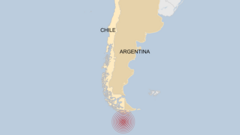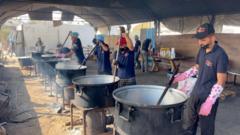The impact of the 7.7-magnitude earthquake on March 28, 2025, in Myanmar's Mandalay region is staggering, with current estimates indicating close to 700 deaths and over 1,600 injuries.
**Death Toll from Myanmar Earthquake Reaches Nearly 700, Thousands Injured**

**Death Toll from Myanmar Earthquake Reaches Nearly 700, Thousands Injured**
Severe earthquake near Mandalay prompts international aid plea as fatalities and injuries climb.
The earthquake that struck near Mandalay was a 7.7-magnitude event, causing extensive destruction and significant loss of life in Myanmar. According to the military government, the death toll has risen to nearly 700, with more than 1,600 individuals reported injured. The quake's epicenter was located just outside Mandalay, affecting areas around the Sagaing Fault, a seismic hot spot in the region.
Witnesses reported scenes of devastation, with buildings reduced to rubble and overburdened hospitals struggling to accommodate the influx of injured. Survivors were observed seeking treatment outside mandated healthcare facilities, which highlights the urgency of a humanitarian response to this disaster. Despite the country's military being internationally isolated and under heavy sanctions, they have publicly requested international aid, an unprecedented move indicating the severity of the situation.
The earthquake's tremors were felt across parts of Southeast Asia, including southern China, Bangladesh, and northern Thailand, where structural damage has also been reported. Concerns are growing that the death toll may ultimately exceed 10,000 given the dense populations and vulnerable infrastructures in the areas affected.
In an alarming prediction, seismic experts from the United States Geological Survey noted that the devastation could escalate once the full scale of the situation is assessed, which may take weeks as communication remains hampered by government controls.
The international community, faced with logistical hurdles due to Myanmar's political climate, is preparing to respond, but apprehensions linger over how the military regime will manage the distribution of aid. As rescue efforts intensify, the enormity of this tragedy grows clearer, with the affected regions needing immediate attention and support in the coming days and weeks.
Witnesses reported scenes of devastation, with buildings reduced to rubble and overburdened hospitals struggling to accommodate the influx of injured. Survivors were observed seeking treatment outside mandated healthcare facilities, which highlights the urgency of a humanitarian response to this disaster. Despite the country's military being internationally isolated and under heavy sanctions, they have publicly requested international aid, an unprecedented move indicating the severity of the situation.
The earthquake's tremors were felt across parts of Southeast Asia, including southern China, Bangladesh, and northern Thailand, where structural damage has also been reported. Concerns are growing that the death toll may ultimately exceed 10,000 given the dense populations and vulnerable infrastructures in the areas affected.
In an alarming prediction, seismic experts from the United States Geological Survey noted that the devastation could escalate once the full scale of the situation is assessed, which may take weeks as communication remains hampered by government controls.
The international community, faced with logistical hurdles due to Myanmar's political climate, is preparing to respond, but apprehensions linger over how the military regime will manage the distribution of aid. As rescue efforts intensify, the enormity of this tragedy grows clearer, with the affected regions needing immediate attention and support in the coming days and weeks.


















